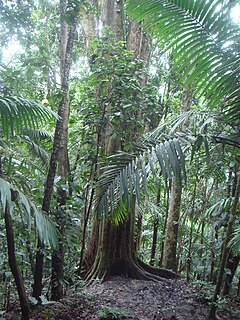
Manilkara chicle is a tropical evergreen tree native to Mexico and Central America. The tree ranges from Veracruz in Mexico south to Atlántico in Colombia. It yields a natural gum known as chicle, traditionally used in making chewing gum and other products.

Manilkara bidentata is a species of Manilkara native to a large area of northern South America, Central America and the Caribbean. Common names include bulletwood, balatá, ausubo, massaranduba, and (ambiguously) "cow-tree".

The Sapotaceae are a family of flowering plants belonging to the order Ericales. The family includes about 800 species of evergreen trees and shrubs in around 65 genera. Their distribution is pantropical.

Manilkara is a genus of trees in the family Sapotaceae. They are widespread in tropical and semitropical locations, in Africa, Madagascar, Asia, Australia, and Latin America, as well as various islands in the Pacific and in the Caribbean. A close relative is the genus Pouteria.

Manilkara zapota, commonly known as sapodilla, sapota, chikoo, chico, naseberry, or nispero is a long-lived, evergreen tree native to southern Mexico, Central America and the Caribbean. An example natural occurrence is in coastal Yucatán in the Petenes mangroves ecoregion, where it is a subdominant plant species. It was introduced to the Philippines during Spanish colonization. It is grown in large quantities in India, Pakistan, Thailand, Malaysia, Cambodia, Indonesia, Vietnam, Bangladesh and Mexico.
Manilkara bolivarensis is a species of plant in the family Sapotaceae. It is endemic to Venezuela.
Manilkara cavalcantei is a species of plant in the family Sapotaceae. It is endemic to Brazil, where it is threatened by habitat loss.

Manilkara dardanoi is a tree species in the sapodilla family. It is endemic to Brazil, and only found in a small portion of Pernambuco. Here it grows in forests mostly along the coast, or elsewhere deeper inland where there is old secondary forest. Its natural habitat is gradually disappearing as forest is felled and land is cleared for human settlement.
Manilkara decrescens is a species of plant in the family Sapotaceae. It is endemic to Brazil, and is threatened by habitat loss.
Manilkara elata, also called the cow tree, is a species of plant in the family Sapotaceae. It is Endemic to the Amazon region in Brazil, where it is endangered by habitat loss.
Manilkara excelsa is a species of plant in the family Sapotaceae. It is endemic to Brazil, and threatened by habitat loss.
Manilkara gonavensis is a tree species in the sapodilla family, found nowhere else but Haiti. It has only ever been collected one time for study, when the type specimen was taken. This was in the early 20th century, before 1929, which is the year it was described. Consequently, very little is known about M. gonavensis, and further study is needed. The specimen was taken from Haiti's Gonâve Island, which is reflected in the choice of its specific epithet.
Manilkara kanosiensis is a species of tree in the sapodilla family. It is thinly dispersed in low-lying rainforests over a large range, from the Maluku Islands of Indonesia to the Bismarck Archipelago of Papua New Guinea. It is endangered by the furious pace of logging in its native habitat, where it is felled as timber.

Manilkara longifolia, commonly known as masseranduba, is a species of plant in the family Sapotaceae. It is endemic to Brazil, where it is threatened by habitat loss.
Manilkara mayarensis is a plant species in the family of sapodillas, which grows wild only in Cuba's Oriente Province. Here its members range in scale from shrubs to small trees. Its usual haunts are along creeks, ravines and other naturally formed watercourses within its montane, serpentine shrubwood habitat.
Manilkara paraensis is a species of plant in the family Sapotaceae. It is endemic to Brazil, where it is threatened by habitat loss.
Manilkara pleeana, the zapote de costa, is a species of plant in the family Sapotaceae. It is endemic to Puerto Rico.
Manilkara rufula is a species of tree in the Sapodilla family. It is endemic to the northeastern submontane forests of Bahia, Sergipe, Pernambuco, Paraíba, Ceará and Piauí states of Brazil. Although this species exists in many places, where it occurs it is either not numerous, or its numbers are declining due to loss of habitat.
Manilkara spectabilis is an uncommon species of tree in the sapodilla family.
Manilkara valenzuelana is a species of tree or tall shrub in the Sapodilla family. It is found in coastal and subcoastal semi-deciduous forests of Cuba, the Dominican Republic, Haiti, and possibly Puerto Rico. Its habitat has been declining rapidly under pressure from charcoal makers, logging, and the clearing of forest for human habitation.







